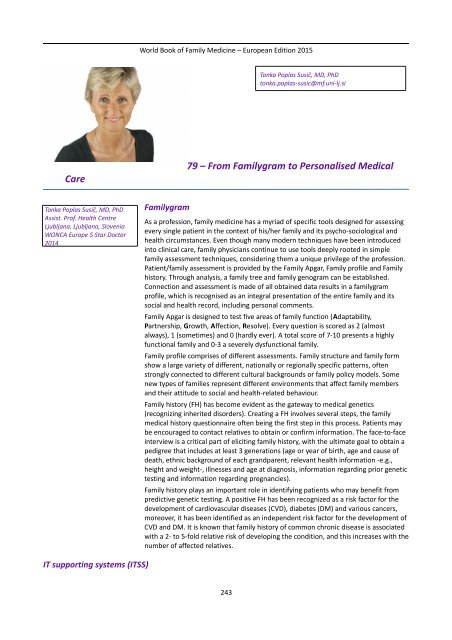Family Medicine
World Book 2015
World Book 2015
You also want an ePaper? Increase the reach of your titles
YUMPU automatically turns print PDFs into web optimized ePapers that Google loves.
World Book of <strong>Family</strong> <strong>Medicine</strong> – European Edition 2015<br />
Tonka Poplas Susič, MD, PhD<br />
tonka.poplas-susic@mf.uni-lj.si<br />
Care<br />
79 – From <strong>Family</strong>gram to Personalised Medical<br />
Tonka Poplas Susič, MD, PhD<br />
Assist. Prof. Health Centre<br />
Ljubljana, Ljubljana, Slovenia<br />
WONCA Europe 5 Star Doctor<br />
2014<br />
<strong>Family</strong>gram<br />
As a profession, family medicine has a myriad of specific tools designed for assessing<br />
every single patient in the context of his/her family and its psycho-sociological and<br />
health circumstances. Even though many modern techniques have been introduced<br />
into clinical care, family physicians continue to use tools deeply rooted in simple<br />
family assessment techniques, considering them a unique privilege of the profession.<br />
Patient/family assessment is provided by the <strong>Family</strong> Apgar, <strong>Family</strong> profile and <strong>Family</strong><br />
history. Through analysis, a family tree and family genogram can be established.<br />
Connection and assessment is made of all obtained data results in a familygram<br />
profile, which is recognised as an integral presentation of the entire family and its<br />
social and health record, including personal comments.<br />
<strong>Family</strong> Apgar is designed to test five areas of family function (Adaptability,<br />
Partnership, Growth, Affection, Resolve). Every question is scored as 2 (almost<br />
always), 1 (sometimes) and 0 (hardly ever). A total score of 7-10 presents a highly<br />
functional family and 0-3 a severely dysfunctional family.<br />
<strong>Family</strong> profile comprises of different assessments. <strong>Family</strong> structure and family form<br />
show a large variety of different, nationally or regionally specific patterns, often<br />
strongly connected to different cultural backgrounds or family policy models. Some<br />
new types of families represent different environments that affect family members<br />
and their attitude to social and health-related behaviour.<br />
<strong>Family</strong> history (FH) has become evident as the gateway to medical genetics<br />
(recognizing inherited disorders). Creating a FH involves several steps, the family<br />
medical history questionnaire often being the first step in this process. Patients may<br />
be encouraged to contact relatives to obtain or confirm information. The face-to-face<br />
interview is a critical part of eliciting family history, with the ultimate goal to obtain a<br />
pedigree that includes at least 3 generations (age or year of birth, age and cause of<br />
death, ethnic background of each grandparent, relevant health information -e.g.,<br />
height and weight-, illnesses and age at diagnosis, information regarding prior genetic<br />
testing and information regarding pregnancies).<br />
<strong>Family</strong> history plays an important role in identifying patients who may benefit from<br />
predictive genetic testing. A positive FH has been recognized as a risk factor for the<br />
development of cardiovascular diseases (CVD), diabetes (DM) and various cancers,<br />
moreover, it has been identified as an independent risk factor for the development of<br />
CVD and DM. It is known that family history of common chronic disease is associated<br />
with a 2- to 5-fold relative risk of developing the condition, and this increases with the<br />
number of affected relatives.<br />
IT supporting systems (ITSS)<br />
243


